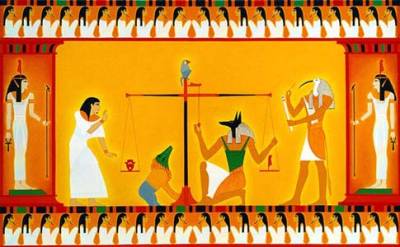This is an old revision of the document!
Map of the Deceased
While this scene only hints at the complexity of the Egyptian beyond, it does provide us with many common themes and riddles found throughout depictions of the Egyptian beyond. This particular depiction details what this person, the deceased, is supposed to do and where this person is to go when he arrives in the beyond. One can think of this depiction as a map of sorts, a map that guides the deceased. So what does this particular map depict?
In the upper left-hand portion of the map, we can see the beginning of this person's journey. It is important to note that the deceased is crouched in a kneeling position, holding his hands high up in the air in reverence, but who is he revering exactly? The first personage he is revering is the sun god himself as one can ascertain from his falcon head. The next personage appears to be either the pharaoh or Osiris himself due to the tall white cap. And the other twelve appear to be divine judges of some sort. This panel appears to be presiding over a court where the deceased must account for his deeds and sins he incurred throughout his life. If he passes this first obstacle (as he does) and is thus deemed worthy of continuing, he will then proceed to the next realm of the map: OsirisÕs palace (or pavilion?).
The deceased is then led hand-in-hand by the jackal god Anubis into the palace. Here, in front of Osiris's room, Anubis tarries the scales and places the deceased's heart in one pan and a feather in the other. This is very significant. The heart, or soul, of the deceased must be as exactly as light as a feather - no more, no less. This suggests that the Egyptians valued balance and equilibrium in the soul. One should not have a “heavy heart” weighed down by deception and sin nor should one be too “light hearted” for that leads to a disruption in the order of things. If the deceased does not have an balanced heart, he will be fed to the beast lying underneath the scales. If this occurs, the deceased will not be given a second life; rather, they will be vanquished forever. The deceased in this picture, however, survives this situation and continues onward to the sun god. He has a balanced heart.
But before the deceased enters the area of Osiris, the deceased must surmount two more obstacles. The first is the writing of his judgment by the god of writing Thoth. Only with Thoth's approval and final written recording can the deceased move forward. He, as I interpret it, is writing the deceased' name an eternal book - a sort of permanent inventory of souls. The second obstacle is the needed approval of the sun god. Only he can allow entrance into the final judgment room of Osiris. Importantly, the sun god is relinquishing his power over the deceased individual and is giving him, like a gift, to Osiris the god of the underworld.
In a side note, if one looks closely at the left side of Osiris's room, one can curiously see a curtain that covers his entrance. This mysterious curtain hints at the sanctity of the room of Osiris. Only the best and most just can enjoy his presence and behold his power. The deceased in the image is fortunate enough to have already passed OsirisÕs judgment points and now he gets to meet the god of the beyond himself. One can see by the dress of Osiris, his snow-white tunic and headdress, that he is a good god, one who assists and introduces the deceased into the beyond. And one can see that Osiris is the most important god by virtue of his animal, the falcon, and his mistresses(?). These auxiliaries attest to his supreme importance and omnipotence in the beyond. The eye located on the breast of the falcon suggests that Osiris oversees all, that nothing of the beyond escapes his immanent power.
It is here, in this end chamber, that the deceased meets the end of one journey, that of the halls of Osiris and his judgment points, and begins a whole new life in the ÒbeyondÓ. Just like the image of the snake biting its own tale, the deceased is at a beginning and an end. With the help of his map, his journey in the halls of Osiris is over, but his journey into the greater beyond has only begun. What lies beyond Osiris's halls is a mystery and a riddle to the deceased and to us.
Citation - Anonymous. “The Funerary Scene”. <http://www.crystalinks.com/egyptafterlife.html>. September 1, 2006.
